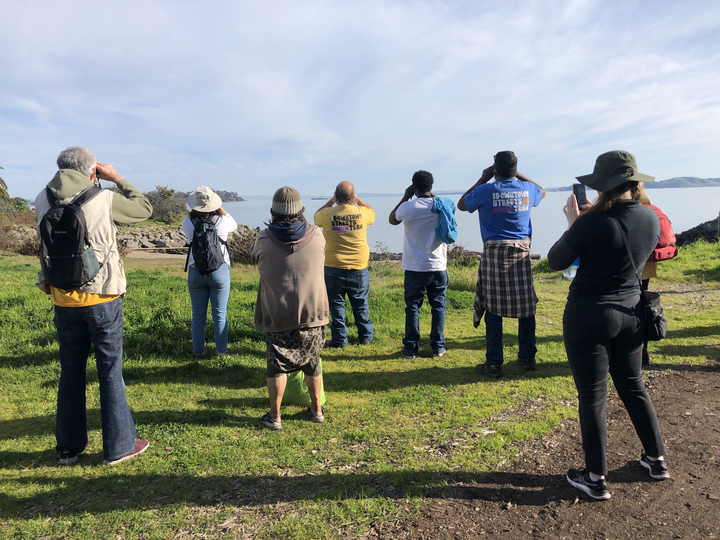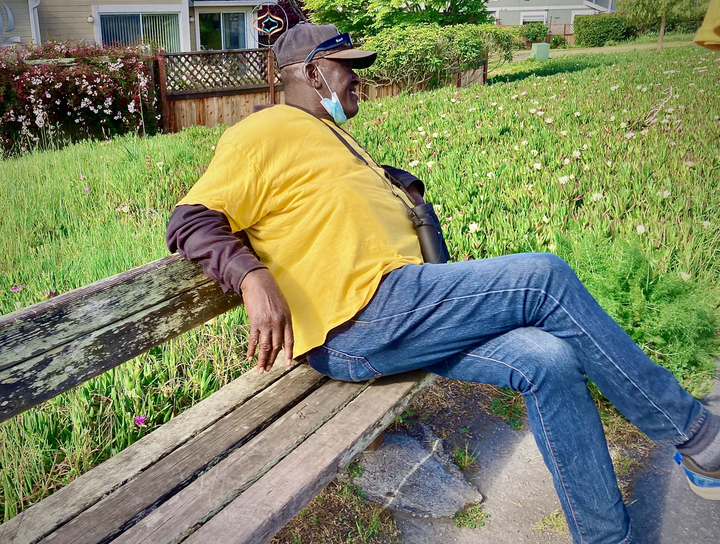"Bird Deafness," Nature Walks, and Eco-Social Justice: Team Members on the Trails with Bella Mayorga
Bella Mayorga shares her love of the Marin wetlands with local Team Members by leading them on Nature and Bird Walks. And they couldn’t ask for a more qualified guide. Bella holds an MS in Environment and Sustainability with a concentration in Geospatial Data Science and Ecosystem Science and Management from the University of Michigan. She serves now as the Education Program Coordinator for the San Francisco Bay National Estuarine Research Reserve (SF NERR,) a wetland science and conservation center in partnership with the National Oceanic and Atmospheric Administration and San Francisco State University.
As an educator, Bella supports meeting people where they are, so her goal is not necessarily to get everyone out to the estuary. These locations can be far for some groups, especially if the funding is not there. Having a small staff at the NERR education center means she is making the most of it by partnering with organizations that already have the capacity to deal with paperwork and transport. Most often, this means well-funded K-12 schools, but Bella is committed to adult education, and service to underserved communities too.
Right now, the Nature and Bird Walks are an informal arrangement, but Bella is eager to expand and formalize it as a program. She has the leadership capacity to do this, but lacks the funds that could alleviate the transportation requirements and time investment borne by DST staff. So, we’re actively searching for grants that can support the amazing Nature and Bird Walks that are described in the interview below.
***
DST: How did you discover Downtown Streets Team?
Mayorga: I encountered DST at the State of the Estuary conference where they presented a session on environmental justice. I thought what a cool organization working with a population who could probably appreciate some outdoor programming and education. So, I went to a Weekly Success Meeting in person, and I felt compelled to help the mission go further. The sense of community there was heartwarming. I felt part of it as well. I talked to Nikki (Employment Specialist) and Zoë (Director of Marin County) to see if the Team Members could benefit from a hands-on environmental learning experience. I explained that I work with NERR and that I could provide that experience for free as part of our mission. I said, if you can coordinate registration and transportation, I can handle the rest. And that’s how the Bird and Nature Walks got started.
DST: How does DST fit in with your educational goals at SF NERR?
Mayorga: As the Education Program Coordinator, my goal is to find communities who are underserved in terms of science education opportunities and see how my program could support their needs. The Bay
Area has a lot of nonprofits focused on education and some support engagement with the estuary, but there’s a lot of emphasis on K-12. When I came into this position, I knew I wanted to expand that demographic to groups that may have never gotten or don’t often get a chance to experience nature in a meaningful way.
The ability to appreciate nature up close in the estuary raises questions of access and social justice. Remote and out-of-the-way places like national and state parks– places where you can feel removed from the normal stresses of daily life– these are more out of reach for people who have to work double shifts, don’t have reliable vacation time or vacation funds, or transportation. This can be exclusionary to the very people who stand to benefit the most. I’ve done a lot of work with first-gen college students and people who didn’t grow up with parents taking them into nature. But seeing groups like Team Members coming in and being invited to look– and learning how to look– is really rewarding.
DST: How do you “learn to look”? Is bird watching the main activity on these walks?
Mayorga: Birds are a big part of it. They make a good topic of inquiry. I remember the first walk we did at Shoreline Park. There was a Team Member who was familiar with all the birds, but he didn’t know what the birds were called because for some people, that’s just not general knowledge. But he knew them by sight and he recognized key aspects of their behaviors. For example, he said that one bird will skitter and then fly away
making a high-pitched, fluttery call, which is in fact very characteristic of a killder, which is a wetland bird. That was impactful for me. It made me think there’s all this untapped knowledge and understanding that Team Members– and other people– possess, but they may not recognize it as having some knowledge of ornithology.
DST: Can you talk more about the avian aspect of the Bird and Nature Walks? What’s special about wetland birds in these experiences?
Mayorga: You see birds all the time, but when you see them with lenses that bring them right to you, you can appreciate them so much more—even the sparrows that you see pecking outside of a food court become a little more special and more interesting through binoculars. That started my love of birds. In college, I did research on birds in urban areas along the Central Coast. I am really interested in urban areas ... how people and animals move in urban areas, and how cities can change geographies to make areas more hospitable for wildlife and people. So, in my role as Education Coordinator, I try to bring that knowledge into the discussion as well as locally-based information that people don’t often know about. Birds are my gateway for talking about wildlife and nature in general.
The Team Members have really fun questions sometimes: like once they asked why the ocean was salty, and I didn’t have a ready answer, so we looked it up. Another asked, “I notice that pigeons bob their head when they
walk, why?” Again, I looked it up. I feel very comfortable saying, “I don’t know. Let’s look it up and talk about it.” I like building up that comfort with them, that dialogue of being able to ask questions about nature. But I also have a lot of fun facts living in my brain for free: like did you know crows have excellent memories? If you mess with a crow, it may not be happy to see you again. Or, that the turkey vultures soaring overhead don’t flap their
wings to stay airborne? They ride rising air currents. The tone of the Walks is very relaxed and meant to give the Team Members an engaging environmental experience.
DST: Are binoculars essential equipment for these Walks?
Mayorga: I make them available. Some Team Members choose not to use them. Some remain a bit off from the group having their own moments of reflection. Others are more engaged. Others are happy using the naked eye, but I love using binoculars because you can see all the detailed movements of the bird’s facial feathers, or how their throats move when they’re singing.You can’t get very close to the birds otherwise. Birds are harder to see if you’re not actively looking for them. People talk about plant blindness, that is the inability to notice plants in one’s own environment. A similar phenomenon occurs with birds, but it also comes with an audio component. “Bird deafness”? [laughs] It’s an inability to hear birds; their chirps are relegated to background noise.
DST: How do you help Team Members overcome “bird deafness” on these Walks?
Mayorga: The last walk was to China Camp, which is a very quiet location. When you live in an urban area, you get used to the noise of hustle and bustle. So, at China Camp we began to work on the social and emotional wellness benefits of being outside, on lowering anxiety, lowering depression. We stand in a minute of silence. I challenge them to listen to as many sounds as they can that are unfamiliar to them. They joked that it felt like summer camp, but they said that it made them feel very peaceful.
Also, I remind them that many of the birds we see here are also present in parking lots, shopping centers, and city parks. So, if they want to ground themselves, they don’t always have to go out to nature, they can just observe those birds and spend a couple of minutes appreciating them.
DST: Are there any ways in which the mission of NERR and DST overlap?
Mayorga: Yes. I’m also compelled to make a connection to the vital volunteer work Team Members do in supporting the estuary. It doesn’t require a lot of imagination to make that connection. It’s actually really strong. When they pick up litter, they prevent the flow of trash to the estuary, and to the birds who could consume that trash and get sick. So, I think they are really performing a service and are excellent stewards of the estuary. It’s great to bring them out and show them that their work contributes to the preservation of this habitat, which is able to support so much wildlife. It’s great to see them empowered.






